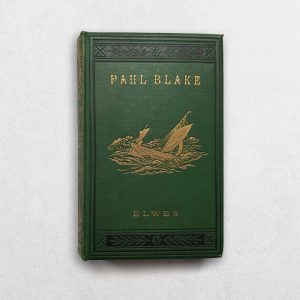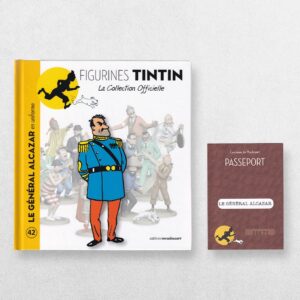Professor Bergamotte Laughing – Figurines Tintin La Collection Officielle – 43 – Le Professeur Bergamotte Hilare
Hergé & Editions Moulinsart
£65.00
Availability: In stock
Product Description
Professor Bergamotte Laughing – Figurines Tintin La Collection Officielle – 43 – Le Professeur Bergamotte Hilare
Author: Hergé & Editions Moulinsart
Price: £65.00
Publisher: Editions Moulinsart
Publication date: 2013
Format: Original pictorial boards with passport and figurine
Condition: In near fine condition
Illustrations: Illustrated throughout
Description:
Original pictorial boards. Includes passport loosely inserted. Text in French. Includes the accompanying figurine. One from the collection of 111 books and figurines. Very slight wear. In very near fine, clean condition overall.
Professor Bergamotte: A Short Account
Professor Hippolyte (or Hercules) Bergamotte is a secondary yet significant character in Hergé’s The Adventures of Tintin, appearing primarily in The Seven Crystal Balls (1948) and briefly in Prisoners of the Sun (1949). A friend and colleague of Professor Cuthbert Calculus, Bergamotte serves as a link between Tintin’s familiar world of European academia and the mysterious, supernatural elements that drive these two interconnected adventures.
Character Profile
Professor Bergamotte is portrayed as an educated and refined man, an archaeologist or ethnologist with a special interest in South American civilisations. Hergé depicts him as middle-aged, intelligent, and composed, with a neatly trimmed beard and spectacles — a figure of scholarly respectability. His speech is formal, his manner courteous, and his surroundings reflect his cultured, comfortable lifestyle.
He is married (his wife appears briefly in The Seven Crystal Balls) and lives in a large country house in the Belgian countryside, surrounded by artefacts from his travels — including the fateful Inca mummy that lies at the heart of the story.
Role in The Seven Crystal Balls
Professor Bergamotte is introduced as one of seven European explorers who participated in the discovery of the tomb of the Inca king Rascar Capac. The expedition, having returned to Europe with stolen treasures, soon falls victim to a mysterious curse: each member is struck down by a coma-like affliction, their glassy eyes and lifeless bodies suggesting supernatural retribution.
Bergamotte, who did not travel to South America himself, hosts the mummy of Rascar Capac in his home — a decision that seals his fate. When Tintin, Captain Haddock, and Professor Calculus visit him to discuss the series of strange attacks, the curse strikes again. A storm rages, lightning flashes, and shards of crystal fall from the ceiling. Moments later, Bergamotte is found unconscious, afflicted by the same malady as the other explorers.
The sequence is one of the most atmospheric and cinematic in all of Hergé’s work. The juxtaposition of modern domestic comfort with ancient mystery — the mummy illuminated by lightning in a bourgeois Belgian drawing room — captures the haunting tone that defines The Seven Crystal Balls.
Role in Prisoners of the Sun
Though Bergamotte remains comatose throughout Prisoners of the Sun, his fate drives the plot. Tintin’s quest to uncover the secret of the crystal balls and rescue the stricken explorers is, in part, an attempt to save Bergamotte and his colleagues from their supernatural punishment.
His home and possessions also provide vital clues that help Tintin trace the origin of the curse to Peru, leading to one of the most dramatic adventures in the Tintin canon.
Relationship with Professor Calculus
Professor Bergamotte’s friendship with Professor Calculus (Tryphon Tournesol) provides a subtle glimpse into Tintin’s extended intellectual circle. The two men represent complementary aspects of scholarship: Calculus the eccentric inventor and scientist; Bergamotte the cultured historian and archaeologist.
Their mutual respect suggests that Hergé imagined a network of European academics connected by curiosity and discovery — a reflection of post-war fascination with exploration and lost civilisations.
Personality and Symbolism
Bergamotte embodies Hergé’s portrayal of the Western scholar — intelligent, rational, but blind to the moral implications of his work. His decision to display the Inca mummy as a curiosity rather than a sacred artefact reflects the arrogance of colonial archaeology, a theme that The Seven Crystal Balls critiques with growing intensity.
The “curse” that befalls Bergamotte and his colleagues can thus be read as poetic justice — a symbolic reckoning for cultural desecration. Hergé’s tone is not vindictive but cautionary: knowledge divorced from respect leads to catastrophe.
Thematic Importance
Through Professor Bergamotte, Hergé explores themes of:
- The limits of rationality: Bergamotte, a man of science, is undone by forces beyond logic.
- Cultural respect: His fate warns against treating ancient cultures as mere curiosities.
- Mystery and the supernatural: His household becomes the setting where the modern and the mystical collide.
The atmosphere surrounding Bergamotte’s downfall — the storm, the lightning, the shattering glass — marks a tonal shift in Tintin’s world, blending realism with gothic suspense.
Artistic Significance
Visually, Bergamotte’s scenes are among Hergé’s most striking compositions. The interior of his house, filled with artefacts, contrasts sharply with the calm domesticity of Tintin’s usual settings. Hergé’s use of light — the flicker of the storm revealing the mummy’s silhouette — evokes a cinematic sense of dread unprecedented in earlier Tintin works.
Legacy
Although he appears in only one and a half stories, Professor Bergamotte plays a pivotal role in Tintin’s most mysterious adventure. His name and fate linger as a reminder of the series’ occasional forays into the uncanny.
He represents a turning point in Hergé’s development as a storyteller — from light-hearted adventure to mature, morally resonant narrative. Through Bergamotte, Hergé bridged the gap between colonial-era curiosity and post-war self-awareness, using the scholar’s downfall to critique hubris and affirm respect for ancient cultures.
Summary
- Full name: Professor Hippolyte (or Hercules) Bergamotte
- Profession: Archaeologist / Ethnologist
- First appearance: The Seven Crystal Balls (1948)
- Associated story: Prisoners of the Sun (1949)
- Traits: Cultivated, intelligent, courteous, rational, and curious
- Fate: Struck by the Incan curse after housing the mummy of Rascar Capac
- Symbolism: The collision between scientific curiosity and sacred mystery
Why Buy from Us?
At Hornseys, we are committed to offering items that meet the highest standards of quality and authenticity. Our collection of objects and rare books are carefully curated to ensure each edition is a valuable piece of bibliographical history. Here’s what sets us apart:
- Authenticity and Provenance: Each item is meticulously researched and verified for authenticity and collation.
- Expert Curation: Our selection process focuses on significance, condition, and rarity, resulting in a collection that is both diverse and distinguished.
- Customer Satisfaction: We aim to provide an exceptional customer experience, from detailed descriptions to secure and prompt delivery of your purchase.
- Returns Policy: We offer an unconditional guarantee on every item. If you wish to return an item, it may be sent back to us within fourteen days of receipt. Please notify us in advance if you wish to do so. The item must be returned in the same condition as it was sent for a full refund.
Cataloguer: Daniel Hornsey
Daniel Hornsey has specialised in fine and rare books, ephemera, and collectors’ editions for over thirty years. As a long-standing member of the antiquarian book trade, he has advised private collectors, curated catalogues, and sourced works for leading dealers, libraries and institutions across the world.
Hornseys’ exhibit regularly at book and map fairs in London and throughout the UK and are members of the Provincial Booksellers Fairs Association, the PBFA.
His fascination with Hergé’s work — especially ‘The Adventures of Tintin’ — began in childhood. Daniel recalls reading Tintin in original European editions and quickly recognising that these were not merely children’s books, but finely illustrated narratives crafted with artistic depth and wit.
As noted by the Musée Hergé in Louvain-la-Neuve, Hergé’s ‘ligne claire’ style has influenced generations of European comic artists and his original drawings and paintings command very high prices with his painting of ‘The Blue Lotus’ jar fetching £2.8m at auction in 2021.
By presenting these works through Hornseys’, he hopes to contribute to the continued appreciation of one of the 20th century’s most influential illustrators, helping new generations discover the artistry and legacy of Hergé.
Related products
Paul Blake Or The Story Of A Boy’s Perils In The Islands Of Corsica And Monte Cristo
£125.00Elwes, Alfred (Leighton Binding)
Paddington Marches On With Card Signed By Michael Bond Loosely Inserted
£545.00Bond, Michael Illustrated By Fortnum, Peggy
You may also like…
General Alcazar In Uniform – Figurines Tintin La Collection Officielle – 42 – Le Général Alcazar En Uniforme
£45.00Hergé & Editions Moulinsart
Colonel Sponsz Upset – Figurines Tintin La Collection Officielle – 37 – Le Colonel Sponsz Contrarié
£55.00Hergé & Editions Moulinsart
Monsieur Boullu The Stonemason – Figurines Tintin La Collection Officielle – 35 – Monsieur Boullu Le Marbrier
£40.00Hergé & Editions Moulinsart
Haddock Alpinist – Figurines Tintin La Collection Officielle – 34 – Haddock En Alpiniste
£45.00Hergé & Editions Moulinsart
Calculus The Gardener – Figurines Tintin La Collection Officielle – 28 – Tournesol En Jardinier
£35.00Hergé & Editions Moulinsart
Haddock As Hadoque – Figurines Tintin La Collection Officielle – 24 – Haddock En Hadoque
£45.00Hergé & Editions Moulinsart
Ridgewell The Explorer – Figurines Tintin La Collection Officielle – 23 – Ridgewell L’Explorateur
£45.00Hergé & Editions Moulinsart
Tintin In Kilt – Figurines Tintin La Collection Officielle – 22 – Tintin En Kilt
£65.00Hergé & Editions Moulinsart
King Muskar Puts On His Gloves – Figurines Tintin La Collection Officielle – 20 – Le Roi Muskar Enfile Ses Gants
£45.00Hergé & Editions Moulinsart
Snowy Stuck In The Crab Tin – Figurines Tintin La Collection Officielle – 19 – Milou Coincé Dans La Boîte De Crabe
£45.00Hergé & Editions Moulinsart
Nestor With The Tray – Figurines Tintin La Collection Officielle – 18 – Nestor Au Plateau
£45.00Hergé & Editions Moulinsart
Chang Points Out Hou Kou – Figurines Tintin La Collection Officielle – 8 – Tchang Indique Hou Kou
£35.00Hergé & Editions Moulinsart
Tintin In A Lunar Spacesuit – Figurines Tintin La Collection Officielle – 7 – Tintin En Scaphandre Lunaire
£55.00Hergé & Editions Moulinsart
Snowy Carries His Bone – Figurines Tintin La Collection Officielle – 6 – Milou Promène Son Os
£40.00Hergé & Editions Moulinsart
Castafiore With The Parrot – Figurines Tintin La Collection Officielle – 5 – La Castafiore Au Perroquet
£75.00Hergé & Editions Moulinsart
Thomson Looking Awkward – Figurines Tintin La Collection Officielle – 4 – Dupond Engoncé
£40.00Hergé & Editions Moulinsart
Professor Calculus With A Spade – Figurines Tintin La Collection Officielle – 3 – Tournesol A La Bêche
£40.00Hergé & Editions Moulinsart
Haddock Doubtful – Figurines Tintin La Collection Officielle – 2 – Haddock Dubitatif
£40.00Hergé & Editions Moulinsart
Tintin In Trenchcoat – Figurines Tintin La Collection Officielle – 1 – Tintin En Trench-Coat
£75.00Hergé & Editions Moulinsart

























